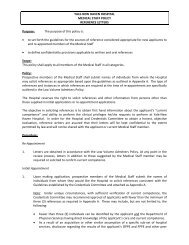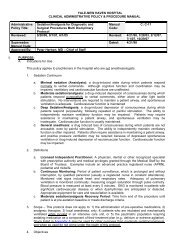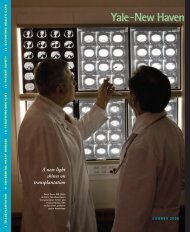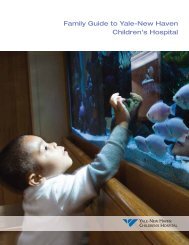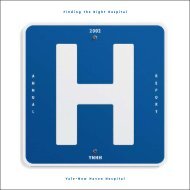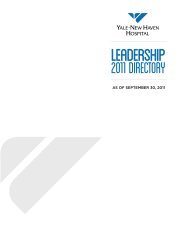Observers - Yale-New Haven Hospital
Observers - Yale-New Haven Hospital
Observers - Yale-New Haven Hospital
Create successful ePaper yourself
Turn your PDF publications into a flip-book with our unique Google optimized e-Paper software.
<strong>Yale</strong> <strong>New</strong> <strong>Haven</strong> <strong>Hospital</strong><br />
Application for Physician <strong>Observers</strong>*<br />
Date:<br />
Medical Staff Sponsor’s Name:<br />
Department / Section:<br />
Observer’s Name:<br />
Dates of Observation:<br />
Purpose of Observation Visit:<br />
Attestation<br />
The individual listed above is requesting to visit <strong>Yale</strong> <strong>New</strong> <strong>Haven</strong> <strong>Hospital</strong> (YNHH) strictly as an observer for the period of<br />
time indicated. I agree that I will be responsible for this individual and he/she will be accompanied at all times by a member<br />
of the Medical Staff while he/she is on YNHH premises.<br />
We agree and understand that, if approved as an observer, the applicant is permitted to observe patient care only and that he/she<br />
will have no patient contact. To this end, he/she will be prohibited from engaging in any of the following: speaking with or<br />
examining patients, providing opinions or consultation about any patient hospitalized at YNHH or reading or writing in patient<br />
medical records. If approved as an observer in the Operating Rooms or other procedural areas, the applicant understands that<br />
he/she must remain unscrubbed at all times and is not permitted to operate any equipment connected with the delivery of<br />
patient care.<br />
The applicant:<br />
<br />
<br />
<br />
<br />
agrees to display appropriate identification while on YNHH premises<br />
agrees to complete the attached immunization testing record and fulfill documentation requirements as<br />
stipulated in the attached letter<br />
attests to having read the YNHH Policies and Procedures regarding Infection Control, Standard Precautions<br />
and Safety and Security<br />
agrees to sign and return “Medical Staff Guest and Observer Confidentiality Agreement”<br />
Medical Staff<br />
Member’s Signature<br />
Date<br />
Observer’s Signature<br />
Date<br />
PLEASE FAX COMPLETED DOCUMENTS TO: 203-688-5343<br />
*Note: Physicians who are not members of the YNHH Medical Staff and wish to participate in patient care may apply as a<br />
“Guest.”<br />
-------------------------------------------------------------------------------------------------------------------------------------------<br />
-------<br />
Department of Physician Services<br />
Reviewed by: ___________________<br />
Date: __________________________<br />
Comments: ____________________<br />
______________________________<br />
1
<strong>Yale</strong> <strong>New</strong> <strong>Haven</strong> <strong>Hospital</strong><br />
Medical Staff Guest and Observer<br />
Confidentiality Agreement<br />
I understand that in my capacity as a Medical Staff Guest or Observer, I may become aware of confidential information such as:<br />
<br />
<br />
<br />
<br />
Patient health care and financial information (otherwise known under HIPAA as “Protected Health Information”)<br />
Employee health care information<br />
Medical Staff information<br />
Business information related to <strong>Yale</strong> <strong>New</strong> <strong>Haven</strong> <strong>Hospital</strong> (including financial, administrative, resource management and other<br />
information)<br />
By signing below, I agree to the following:<br />
a. I understand that access to the information noted above in a verbal, written or electronic (stored in a computer) form is a privilege.<br />
I also understand that access to any YNHH information is granted to me based solely on a clinical “need to know” basis depending<br />
upon the limitations of my approved level of involvement in patient care activities at YNHH.<br />
b. I agree that I will not share with others any information about any patient, including the name or address of the patient or the fact<br />
that the individual is or was a patient at YNHH. I will not share this information with my colleagues, family, friends or anyone not<br />
directly involved in the care of the patient.<br />
c. I understand that any photography, video or audio recording is prohibited and will result in immediate revocation of my<br />
appointment.<br />
d. For Medical Staff Guests: I agree to access information only on patients in whose care I am involved as noted specifically on my<br />
Medical Staff Guest application.<br />
For Medical Staff <strong>Observers</strong>: I understand that I may be privy to information on patients who are under the care of the Medical<br />
Staff member to whom I am assigned.<br />
e. I understand that patient information may not be used by me for research or teaching purposes unless authorized by the appropriate<br />
institutional review board and in compliance with YNHH or <strong>Yale</strong> <strong>New</strong> <strong>Haven</strong> Health System (YNHHS) Policies and Procedures.<br />
f. I understand that the methods I use to get information may only be used relative to my limited role as a Medical Staff Guest or<br />
Observer. I understand that I may not use the personal identification number, sign-on code, password, physical token device of any<br />
person at any time. I understand that violation of this Agreement may result in possible legal action, fines or criminal prosecution<br />
against me.<br />
g. I understand that I may not seek access to any information that is not authorized under the scope of my role as a Medical Staff<br />
Guest or Observer. I understand that patient information accessed via computer is considered the equivalent to the patient’s<br />
medical record and may not, under any circumstances, be re-disclosed without proper authorization as covered in the YNHH<br />
Medical Staff Bylaws and Rules & Regulations.<br />
h. I agree to access, use, store and dispose of information which I am authorized to access in a manner that ensures continued security<br />
and confidentiality in accordance with YNHHS/YNHH Policies & Procedures.<br />
i. I understand that computer hardware, software, and information are considered YNHH property and are subject to and protected by<br />
appropriate YNHHS/YNHH Policies & Procedures.<br />
j. I understand that YNHH reserves the right to make modifications to its program concerning access to Protected Health Information.<br />
k. I understand that my Medical Staff Guest/Observer privileges will be automatically revoked in the event of violation of any of the<br />
above. In addition, violation of this Agreement may result in possible legal action, fines or criminal prosecution against me and, as<br />
applicable, the organization I represent.<br />
l. I agree to indemnify and hold YNHH harmless from and against any and all claims, losses, costs and expenses including,<br />
reasonable attorneys’ fees, related to or arising from any violation of the terms of this Agreement.<br />
Printed<br />
Name:<br />
Signature:<br />
Date:<br />
2
YALE-NEW HAVEN HOSPITAL<br />
IMMUNIZATION TESTING RECORD<br />
NAME:<br />
DEPARTMENT:<br />
SS#:<br />
DATE:<br />
RUBEOLA VACCINE<br />
DOCUMENTATION OF IMMUNIZATIONS/TITERS<br />
DATE<br />
RESULT<br />
RUBEOLA TITER (if no vaccine)<br />
RUBELLA VACCINE<br />
RUBELLA TITER (if no vaccine)<br />
MMR VACCINE<br />
Have you had the chickenpox<br />
YES_____ NO_____<br />
VARICELLA TITER (if done)<br />
VARICELLA VACCINATION (if done but<br />
not required)<br />
PPD, MANTOUX (within the last year, if<br />
PPD-Negative)<br />
If PPD positive, did you have a chest x-ray:<br />
YES_______<br />
NO_______<br />
If PPD positive, did you receive prophylactic anti-tuberculous therapy:<br />
YES_______<br />
NO_______<br />
Have you received the Hepatitis B Vaccine series:<br />
YES_______<br />
NO_______<br />
What was the result of your Hepatitis B surface antibody test following<br />
the vaccine series:<br />
POSITIVE_______<br />
NEGATIVE_______<br />
3
Dear Colleague:<br />
Based upon current standards of OSHA/AHA/JCAHO and <strong>Hospital</strong> policy, applicants to the Medical Staff and<br />
Clinical Fellows are requested to forward their immunization/test records to the Department of Physician Services.<br />
For your convenience, a standardized reporting form is enclosed. Specifically, documentation of the following is<br />
required:<br />
MEASLES (for those whose DATE OF BIRTH is 1/1/57 or later), statement of history of illness is not<br />
acceptable:<br />
A statement of date of positive antibody titer<br />
Or<br />
Date of Immunization (done after 1/1/69)<br />
RUBELLA (for those whose DATE OF BIRTH is 1/1/57 or later), statement of history of illness is not<br />
acceptable:<br />
A statement of date of positive antibody titer<br />
Or<br />
Date of Immunization<br />
HEPATITIS B<br />
A statement of date of positive antibody titer<br />
Or<br />
Date of completion of Immunization series<br />
Or<br />
Signed attached waiver<br />
VARICELLA-ZOSTER VIRUS<br />
A statement of history of illness (chicken pox, shingles, or varicella-zoster)<br />
IF NEGATIVE HISTORY, THEN, result of antibody titer.<br />
TB SKIN TEST<br />
A statement of result of Montoux skin test, done since 7/1/98.<br />
Negative result will require annual TB skin testing; if positive, please provide reason {exposure or<br />
BCG vaccination}, date of evaluation, summary of treatment and chest x-ray report since first<br />
becoming positive.<br />
4
Any applicant, who, as a member of the <strong>Yale</strong>-<strong>New</strong> <strong>Haven</strong> <strong>Hospital</strong> Housestaff had immunizations/testing<br />
performed during their training, will need to PERSONALLY REQUEST that the Occupational Health Services<br />
(203-688-2232), forward a copy of the immunization records to the Department of Physician Services, Hunter 4.<br />
To become compliant if your records are unavailable, please arrange testing and reporting with your personal<br />
provider.<br />
Thank you for your cooperation in providing documentation regarding this important matter.<br />
Sincerely yours,<br />
Peter N. Herbert, M.D.<br />
Chief of Staff<br />
5
Dear Colleague:<br />
Physician guests and observers with a potential for exposure to infectious agents or with a potential for<br />
transmitting infectious agents to others must be knowledgeable of YNHH's Infection Control, Standard<br />
Precautions, Bloodborne Pathogens Standards and TB Control (Airborne Precautions) and Policies and<br />
Procedures. While on YNHH premises, physician guests and observers must also be cognizant of YNHH<br />
Policies and Procedures regarding Safety and Security. The following information outlines all of this<br />
information and must be read.<br />
Any questions concerning these policies should be directed to Occupational Health Services (tel. 688-2462)<br />
or to the Department of Quality Improvement Support Services, formerly <strong>Hospital</strong> Epidemiology, (tel. 688-<br />
4634).<br />
Please recognize that while we have a need to comply with regulatory agencies, <strong>Yale</strong>-<strong>New</strong> <strong>Haven</strong> <strong>Hospital</strong>'s<br />
overriding concern is the protection of its patients and its health care team. Your cooperation and<br />
collaboration in this effort is very much appreciated.<br />
Yours sincerely,<br />
Peter N. Herbert, M.D.<br />
Chief of Staff<br />
6
Policy for Documentation of Staff Physician Education on Communicable Disease Prevention and Control of Transmission<br />
at YNHH<br />
YALE-NEW HAVEN HOSPITAL'S STANDARD (BLOODBORNE PATHOGENS) PRECAUTIONS POLICY<br />
Scope: For the purpose of this document, the definition of Health Care Worker (HCW) is any person with patient<br />
contact, including but not limited to: attending physicians, postdoctoral fellows, house staff, medical students,<br />
physician assistants, nurse-midwives, and their trainees. Similar policies govern the activities of hospital<br />
employees and other CDC-defined HCWs.<br />
The <strong>Yale</strong>-<strong>New</strong> <strong>Haven</strong> <strong>Hospital</strong> Policy for Bloodborne Pathogens is in compliance with CDC/OSHA<br />
recommendations and mandates. The YNHH Infection Control Committee endorses the CDC/OSHA<br />
recommendations for the application of Standard Precautions (formerly referred to as Universal Precautions) to all<br />
patients, regardless of a patient's diagnosis, and to any materials or equipment contaminated by blood or body<br />
fluids during medical practice.<br />
All HCWs should be aware of the documented routes of transmission of HIV, HBV, and HCV and protect<br />
themselves accordingly. Although nosocomial transmission of bloodborne pathogens is rare, Standard<br />
Precautions must be utilized in the care of ALL patients regardless of their diagnosis. This includes:<br />
1. Hands should be cleansed before and after contact with all patients using antiseptic soap and water or an<br />
alcohol-based hand rub. If hands or other body surfaces come in contact with blood or body fluids, wash them<br />
immediately with antiseptic soap and water.<br />
2. Gloves should be worn when contact is anticipated with blood or any body fluids except sweat. Gloves need<br />
not be worn in other ordinary patient care contact. Gloves should be discarded prior to leaving the patient's<br />
room and hands washed immediately after each patient encounter. Double gloving may reduce the risk of<br />
blood exposure when performing surgical procedures.<br />
3. Gowns/aprons, masks, and eye protection are indicated when there is a risk of exposure to blood or body fluid<br />
through close contact, splashing, or aerosolization, such as in suctioning, endoscopy, surgery, delivery<br />
(vaginal or C-section) and catheterization.<br />
4. Do not recap needles/syringes. Discard used, uncapped needles/syringes and sharps (scalpels, forceps,<br />
razors, trocars, etc.) in a puncture-resistant container specified for this purpose. Containers (sharps boxes)<br />
are located in all patient rooms and treatment rooms.<br />
5. Eating, drinking, applying cosmetics, lip balm, or handling contact lenses is prohibited in clinical patient care<br />
areas.<br />
6. When significant exposure to blood or body fluid occurs (e.g. needlestick, mucous membrane splash, or<br />
contact with non-intact skin), report the incident IMMEDIATELY to a hospital supervisor, and go to the YNHH<br />
Occupational Health Service located in suite 130 of the Grace Building for evaluation and recommendations<br />
for post-exposure prophylaxis and follow-up. If the exposure occurs after hours or on a weekend, go to the<br />
<strong>Yale</strong>-<strong>New</strong> <strong>Haven</strong> <strong>Hospital</strong> Emergency Department for evaluation. Bloodborne pathogen exposures should be<br />
evaluated immediately so that a decision can be made within 1-2 hours of exposure whether to administer<br />
antiretroviral and/or Hepatitis B prophylactic treatment. This includes those persons previously immunized<br />
with the Hepatitis B vaccine. A YNHH Supervisor's Report of Employee Accident/Injury (F1797) form should<br />
be completed for all significant exposures. YNHH Occupational Health Services should be notified of each<br />
incident REGARDLESS of the health care worker's usual source of medical care. Questions concerning<br />
reporting and follow-up can be directed to YNHH Occupational Health Services (688-2462). Post-exposure<br />
evaluation may include periodic blood testing.<br />
In many cases, blood testing of the source patient is also indicated. If the source patient does not consent to such<br />
testing, Connecticut State law details a specific process for determining the patient’s bloodborne pathogen infection<br />
7
status. This process includes consultation with a review committee, which is appointed by the Chief of Staff.<br />
Questions concerning this procedure should be directed to the Chief of Staff's office or Legal Affairs.<br />
7. Using the above criteria as guidelines, appropriate clinical judgment should be used when determining which<br />
protective barriers (i.e. personal protective equipment) are needed. Each area must establish its own<br />
standards for consistent use of OSHA-required protective barriers; these unit standards should be based on<br />
the health care worker's skills and the reasonable possibility of contact with the patient's blood or body fluids,<br />
non-intact skin, and mucous membranes.<br />
BLOODBORNE PATHOGENS AND THE HEALTH CARE WORKER:<br />
HIV(+) HCWs should be under the care of a personal physician for appropriate immunization, prophylaxis, and<br />
treatment as indicated. Health care providers who are sero-positive for a bloodborne pathogen (e.g. HIV, Hepatitis<br />
BsAg+) should report, in confidence, to a special standing committee chaired by the Chief of Staff of YNHH to<br />
receive assistance in determining their fitness to continue to safely provide patient care. The continuing safety of<br />
the immuno-compromised health care worker, who may be exposed to infectious disease(s), is among the factors<br />
that should be discussed. All medical information will be reviewed with the individual's responsible personal<br />
physician, and all proceedings and information will be handled in a strictly confidential manner. PPD testing of<br />
HIV(+) HCWs is the same as for other HCWs (see section on TB below).<br />
Any potentially significant patient exposure to the blood of any HCW should be reported, in confidence, to<br />
Occupational Health Services, Department of Quality Improvement Support Services (<strong>Hospital</strong> Epidemiology), or<br />
the Chief of Staff for specific advice.<br />
PRE-APPOINTMENT EVALUATION AND IMMUNIZATION STATUS:<br />
Staff with direct patient contact should know their initial immunization or immune status with regard to:<br />
A. Measles, Rubella<br />
B. Hepatitis B<br />
C. Tuberculosis (PPD [Mantoux] skin test)<br />
D. Varicella (Chickenpox) [either by history, antibody titer, or vaccination]<br />
Documentation of the above will be part of the MEDICAL STAFF OFFICE FILE. Employees of <strong>Yale</strong>-<strong>New</strong> <strong>Haven</strong> <strong>Hospital</strong><br />
will have immunization status, past medical history, and PPD testing as part of their Occupational Health charts.<br />
Varicella-zoster: HCWs without a known history of chickenpox/shingles, without a known positive serology for<br />
varicella-zoster antibody, or HCWs previously vaccinated for varicella should exclude themselves from direct care<br />
of patients with chickenpox or zoster infections until the patient's lesions have crusted over. Varivax R , a live<br />
attenuated vaccine for varicella zoster, is recommended for varicella-negative health care providers and is<br />
available free of charge at the YNHH Occupational Health Service.<br />
If a non-immune or vaccinated healthcare worker has a significant exposure to varicella or zoster, he/she should<br />
contact Occupational Health Services or <strong>Hospital</strong> Epidemiology at once and follow the standard protocol(s) as<br />
instructed.<br />
Influenza: All healthcare workers are strongly encouraged to receive annual immunization against influenza.<br />
Non-immunized healthcare workers with significant exposure to influenza should contact Occupational Health<br />
Services, their primary physician, or an ID specialist regarding recommendations for anti-viral prophylaxis.<br />
Any healthcare worker who develops influenza should take a medical leave of absence from direct patient care<br />
until symptoms have completely resolved.<br />
Measles/Rubella: All healthcare workers must prove immunity to measles and rubella or receive appropriate<br />
immunization. If a HCW who is non-immune or has an unknown immunization status is exposed to a patient with<br />
8
measles or rubella, he/she should report that exposure to Occupational Health Services or <strong>Hospital</strong> Epidemiology<br />
immediately.<br />
Hepatitis: All healthcare workers involved in direct patient care or with exposures to patient specimens must<br />
receive Hepatitis B vaccination, and/or have documentation of Hepatitis B surface antibody positivity, or have<br />
signed a vaccination declination form. Post-immunization testing is now recommended. The primary physician or<br />
YNHH Occupational Health Services may prescribe additional boosters for those who remain sero-negative<br />
following evaluation.<br />
GUIDELINES AND STANDARDS FOR TUBERCULOSIS CONTROL:<br />
All patients with suspected or confirmed active pulmonary TB should be placed on Airborne Precautions in<br />
negative pressure isolation rooms according to the policies outlined in the Infection Control Manual. HCWs must<br />
use an NIOSH-approved respirator until the patient is documented to be non-infectious and Airborne Precautions<br />
have been discontinued. Fit testing for use of such respirators is required. You may arrange for fit testing by<br />
calling 688-2462. <strong>Hospital</strong> Epidemiology must be notified of all confirmed TB cases (excluding those from<br />
Winchester Chest Clinic). All patients with documented pulmonary TB must be reported to State and Local Health<br />
Departments. Patients who fail to continue or complete therapy or are lost to follow-up must also be reported.<br />
Connecticut State Law requires notification of the local public health department prior to discharge so appropriate<br />
follow-up and treatment can be coordinated. The patient cannot be discharged from the hospital until this<br />
requirement is fulfilled (i.e. the local health department must have agreed to the discharge plan).<br />
All HCWs should have PPD testing at least annually as recommended in the 1994 CDC Guidelines for the<br />
Prevention and Control of Tuberculosis in Healthcare Facilities. PPD results must be recorded as part of YNHH<br />
and Medical Staff required documentation. Healthcare workers who work in certain areas of the hospital may<br />
have an increased risk of contact with potentially infectious respiratory droplets and may require PPD testing more<br />
frequently as determined by YNHH Occupational Health Services and the Infection Control Committee (depending<br />
on the prevalence of TB patients encountered and overall staff PPD conversion rates).<br />
PPD (Mantoux) testing may be done at any site convenient to the individual physician, but test results must be<br />
recorded and reported to the Medical Staff Office. Individuals without current PPD tests are not eligible for<br />
reappointment.<br />
Healthcare workers with previously documented positive PPDs are not required to complete annual PPD testing. Such<br />
persons should be aware of the signs and symptoms of active TB and report such symptoms immediately to YNHH<br />
Occupational Health Services should they occur.<br />
All HCWs with newly (or previously unknown) positive PPDs should be evaluated for active pulmonary TB with a<br />
chest x-ray and sputum examinations where appropriate. Any PPD skin test positive HCW with pulmonary<br />
symptoms (e.g. persistent cough, hemoptysis) must refrain from direct patient care until evaluation for pulmonary<br />
TB is complete. Results of this evaluation and/or decision for chemoprophylaxis or treatment must be reported to<br />
the Medical Staff Office.<br />
Any HCW with active tuberculosis may NOT resume direct patient care until proven non-infectious by sputum<br />
examination and must demonstrate compliance with antituberculous therapy for the entire prescribed duration.<br />
HCWs with multi-drug resistant TB infections may require more extensive clinical assessment before returning to<br />
work.<br />
OTHER INFECTION CONTROL POLICIES:<br />
All other YNHH isolation policies and procedures, injury prevention, decontamination, and hazardous waste<br />
handling procedures are defined in the YNHH Infection Control Manual available on the clinical workstations<br />
(YNHH intranet) or at http://info.med.yale.edu/ynhh/infection.<br />
9
Long natural nails and artificial nails have been linked to the transmission of organisms and infections to patients<br />
in healthcare settings. A Natural and Artificial Nail Policy is in effect at YNHH as of October 1, 2004. The policy<br />
applies to all persons in the healthcare setting who have any contact with patients, patient care equipment,<br />
supplies and medications, and those persons involved in the preparation of medication or food. The policy<br />
specifies that natural nails are to ¼ inch or less in length, clean and well manicured, and nail polish, if worn, must<br />
be of a single color and free of cracks and chips. Artificial nails, nail tips, nail jewelry/foreign bodies, rhinestones<br />
and nail sparkles are not permitted.<br />
All HCWs with a potentially transmissible infectious disease (infectious diarrhea, acute respiratory illness, skin infections,<br />
etc.) are expected to exercise appropriate clinical judgment in excluding themselves from direct patient care for the<br />
duration of the potential transmission period. YNHH Occupational Health Services, the Department of <strong>Hospital</strong><br />
Epidemiology, or the Student or Occupational Health Services of <strong>Yale</strong> University should be consulted for individual advice.<br />
The Department of Quality Improvement Support Services (<strong>Hospital</strong> Epidemiology), acting for the YNHH Infection Control<br />
Committee, has the ultimate responsibility for recommendations in such cases.<br />
REPORTABLE DISEASES: The Department of Quality Improvement Support Services (<strong>Hospital</strong> Epidemiology)<br />
will assist physicians in the appropriate reporting of communicable diseases in patients at YNHH to the Local and<br />
State Health Departments. Please call 688-4634 for assistance. During non-business hours please leave a<br />
message with your name, phone number, the patient's name, unit number, ward or clinic and diagnosis.<br />
Hand Hygiene<br />
The single most important thing you can do to protect yourself and your patients.<br />
Before and after each patient contact<br />
After removal of gloves<br />
Alcohol based hand rub<br />
<br />
<br />
<br />
No sink, soap or paper towels needed<br />
Takes less time<br />
Better for your skin<br />
Water is the major ingredient<br />
Contains emollients<br />
For visibly soiled hands or after exposure to blood or body fluids, use soap and water for 15 seconds to cleanse your hands.<br />
Set a good example for your colleagues and other healthcare workers!<br />
10
YNHH On-Line Information<br />
SAFETY MANUAL<br />
Occupational Health and Facilities Safety Training<br />
All Health & Safety policies are located in the <strong>Hospital</strong>’s Safety Manual<br />
Human Resources (HR) Intranet: http://hrweb.mis.ynhh.com, click on the OHS button in the left-hand frame,<br />
click on “Safety” in the right-hand frame to go to the Safety Manual Table of Contents.<br />
Clinical WorkStation: From the Clinical WorkStation homepage, click on the “S” in the Resources A-Z listing<br />
in the left-hand frame, scroll the listing in the right-hand frame to find “Safety Manual” and click on it to go to<br />
the Safety Manual Table of Contents.<br />
** You must be using a <strong>Hospital</strong> computer to log onto the HR Intranet site. **<br />
Clinical WorkStation homepage: http://info.med.yale.edu/medmenu/ynhh/ClinicalWorkStation<br />
A. TYPES OF DISASTERS<br />
11<br />
EMERGENCY PREPAREDNESS<br />
An Internal Disaster is an incident within the <strong>Hospital</strong> which compromises its structural integrity, results in<br />
injuries to staff and/or patients, or otherwise threatens the <strong>Hospital</strong>’s ability to care for patients. YNHH<br />
internal disaster protocols include detailed instructions for the following:<br />
telephone interruption<br />
steam interruption<br />
water interruption<br />
electricity interruption<br />
major compressed gas interruption or leak<br />
fire, smoke or explosion<br />
major chemical spills<br />
radiation accidents<br />
biological accidents<br />
bomb threat<br />
An External Disaster is an event within the community or region resulting in multiple casualties like fire,<br />
explosion, hurricane, transportation accident, or civil disorder.<br />
B. LEVELS OF RESPONSE<br />
There are three levels of response to a disaster. They include:<br />
1. Disaster Alert is the normal operating mode for the Emergency Department. ED staff are aware of<br />
the number and status of patients in the ED and the staffing of the ED. A Disaster Alert may also be<br />
used to find individuals critical to running a disaster.<br />
2. A Level I Alert is activated when critically injured patients have arrived or are expected. These<br />
patients usually come from the same incident and require extensive medical or surgical care. There<br />
is no specific number of incoming patients associated with the Level I Alert - it is dependent on the<br />
acuity of the incoming patients and the current activity in the Emergency Department.<br />
3. A Level II Alert is designed to modify the <strong>Hospital</strong>’s operations to accommodate an unexpected,<br />
acutely ill or injured patient volume that would otherwise overwhelm institutional resources. A Level<br />
II Alert is activated when a confirmed multiple casualty incident has occurred and the <strong>Hospital</strong><br />
expects to receive severely injured patients. Again, there is no specific number of incoming patients<br />
associated with a Level II Alert. A Level II Alert is activated when the incoming patient load would or<br />
could compromise hospital resources, not just the Emergency Department. When a Level II Alert is<br />
activated a Plan D will be put into effect and the following announcement will be made over the<br />
paging system: “Attention all <strong>Hospital</strong> personnel, Plan D is now in effect”. Three chimes precede this<br />
announcement.
BE PREPARED TO ACT QUICKLY, CORRECTLY AND CALMLY:<br />
Be familiar with the basic elements of the <strong>Hospital</strong>’s Emergency Preparedness Plan found in the<br />
Safety Manual. This is a detailed emergency response plan that describes how to report<br />
emergencies, assigns responsibilities for coordinating and carrying out evacuations, reviews the level<br />
of response to a disaster, examines how we will deal with specific emergencies and reviews the<br />
Weather Contingency Plan.<br />
Know how to recognize and turn on emergency alarms.<br />
Know what to do in an emergency, including assisting patients, evacuation routes, where fire<br />
extinguishers, fire hoses and fire pull stations are located, how to use a fire extinguisher, the<br />
<strong>Hospital</strong>’s emergency phone number (119), who to call, etc.<br />
FIRE SAFETY<br />
Q. What Do You Do In The Event Of A Fire In The <strong>Hospital</strong><br />
A. Follow The R.A.C.E. Protocol:<br />
R= Rescue anyone in immediate danger<br />
A= Sound the Alarm - activate a pull station, phone “119” (the <strong>Hospital</strong>’s Emergency Page<br />
Phone Number) to report<br />
C= Close all doors, chutes, windows, etc. to Confine the smoke/fire<br />
E= Extinguish the fire by using a handheld fire extinguisher<br />
The overhead paging system will signal with a set of three chimes and announce "Order Number One,<br />
(the location - building and floor)" three times. NOTE: Normal overhead paging is suspended during the<br />
time of a fire emergency except for Code 5 or Code 7 emergencies (adult or pediatric respiratory or<br />
cardiac arrests).<br />
Never open a door if it is hot to the touch. Keep fire doors closed and automatically closing fire doors,<br />
corridors and stairwells free of obstructions.<br />
Patient evacuation is only performed in the event of a large, uncontrollable fire or other widespread<br />
disaster where patient care and the infrastructure of the building are compromised. Horizontal evacuation<br />
is performed - exit through a set of bi-swing, automatically closing fire doors to the safe area beyond the<br />
doors. In the event that further evacuation is necessary, evacuate to a lower floor by using the stairs<br />
(never a higher floor). House Staff, Nursing Staff and the <strong>New</strong> <strong>Haven</strong> Fire Department control patient<br />
evacuation with assistance from the <strong>Hospital</strong>’s Emergency Response Team (ERT). Elevators cannot be<br />
used, except at the discretion of the <strong>New</strong> <strong>Haven</strong> Fire Department who take control of the fire situation<br />
upon arrival.<br />
Every area and room of the <strong>Hospital</strong> contain smoke detectors and sprinklers. It is extremely unlikely that<br />
patient evacuation will need to be performed in the event of a fire.<br />
There is no smoking in the <strong>Hospital</strong>. If you smoke, you need to do so in the smoking enclosure that is<br />
outside the main entrance to the <strong>Hospital</strong>. There is no smoking outside any of the entrance doors to the<br />
<strong>Hospital</strong>. All smoking materials are to be disposed of in the appropriate receptacle.<br />
Q. How Do You Use A Handheld Fire Extinguisher<br />
A. Follow P.A.S.S.:<br />
P= Pull the pin at the top of the extinguisher<br />
A= Aim at the base of the fire<br />
S= Squeeze the top handle to the bottom handle<br />
S= Sweep the horn, hose or nozzle from side-to-side as you extinguish the flames<br />
12
USE THE RIGHT FIRE EXTINGUISHER FOR THE JOB<br />
TYPE OF FIRE DESCRIPTION TYPE OF<br />
EXTINGUISHER<br />
A<br />
Normal combustibles A *<br />
such as paper, wood,<br />
upholstery, cloth<br />
B<br />
Flammable liquids such<br />
as grease, paints, and<br />
oil<br />
BC *<br />
DESCRIPTION<br />
pressurized water<br />
silver cylinder,<br />
gauge at top,<br />
hose<br />
carbon dioxide<br />
red cylinder,<br />
horn or nozzle<br />
C electrical BC as above<br />
A, B, C as above ABC dry chemical<br />
red cylinder,<br />
gauge at top, hose<br />
* Only pressurized water and carbon dioxide extinguishers are used on patient care units.<br />
Only attempt to extinguish a fire that is no larger than a wastebasket. Always have one other person with<br />
you, use the entire contents of the fire extinguisher, and have an exit at your side or back. Even if you<br />
successfully extinguish the fire, all phases of the R.A.C.E. protocol must be followed to ensure that proper<br />
evaluation of the situation has taken place.<br />
MEDICAL WASTE<br />
The following items are medical waste and must be disposed of in leak-proof, biohazard containers or<br />
bags:<br />
sharps<br />
items visibly dripping with blood or body fluids contaminated with blood<br />
Please refer to the Medical Waste chart found on the following page.<br />
13
MEDICAL WASTE CLASSIFICATION AND SEPARATION REFERENCE CHART<br />
The following items are MEDICAL WASTE:<br />
The following items are NOT MEDICAL WASTE<br />
unless visibly dripping waste blood.<br />
1. SHARPS: to be deposited into the designated needle disposal containers. Dispose in ordinary waste containers:<br />
BLADES, GLASS SLIDES, GLASS TUBES<br />
NEEDLES- IV, HYPODERMIC, SPINAL, SUTURE<br />
LANCETS, PROBES, SAFETY PINS, SHEARS, SCRAPPERS, SCISSORS<br />
SYRINGES WITH OR WITHOUT NEEDLE, VACUTAINERS EMPTY SPECIMEN CONTAINERS<br />
GLASS MEDICATION VIALS DRESSINGS, GAUZE, 3 X 4 PADS, ETC.<br />
CHUX, SWABS, SPLINTS<br />
2. VISIBLY DRIPPING WASTE BLOOD: contain fluids where possible MASKS, GLOVES, GOWNS<br />
and deposit any items saturated with visibly dripping blood in TAPE, PADS, COTTON<br />
regulated waste container. SUTURES- without attached needle<br />
INFECTIOUS WASTE CEREBROSPINAL AND PLEURAL FLUIDS: RESPIRATORY SUCTION TUBING<br />
Void container of fluids where possible and deposit containers and/or VENTILATOR TUBING<br />
sealed units in regulated waste containers. FOLEY BAGS, FOLEY CATHETERS<br />
OR SPONGES, SUCTION TUBING & CANISTER LINERS, RED RUBBER CATHETERS<br />
OTHER SUCTION TUBING CONTAINING BLOOD, PLEUREVACS, HEMOVACS BED PANS, EMESIS BASINS<br />
BLOOD TRANSFUSION & PHERESIS FILTERS, TUBING & BAGS DIAPERS<br />
HEMODIALYSIS & CVVH FILTERS & TUBING URINALS, TOILET HATS<br />
1 LITER GLASS VACCUM BOTTLES (USED TO REMOVE ASCITES) PERI (OB) PADS<br />
SPECIMEN CONTAINERS (MOSTLY FROM LABS) SALEM SUMP (NG) TUBES<br />
IRRIGATION SETS, BULB SYRINGES<br />
3. ALL WASTE FROM BIOSAFETY LEVEL 4 AGENTS: All waste from a person PAPER TOWELS, TISSUES, CUPS<br />
with biosafety level 4 disease, such as viral hemorrhagic fever. PACKAGING MATERIALS<br />
CASTS, CAST PADDING<br />
4. CULTURES AND STOCKS of agents infectious to humans and associated PLASTIC MEDICATION VIALS<br />
biologicals including cultures from medical, clinical and hospital PERITONEAL DIALYSIS BAGS & TUBING<br />
laboratories; culture dishes and devices used to transfer, inoculate,<br />
or mix cultures<br />
5. RESEARCH ANIMAL WASTE which includes contaminated animal carcasses, Remove all needles from tubing and if the tubing is NOT visibly dripping<br />
waste blood, deposit animal bedding or animals that were intentionally exposed to tubing in ordinary waste container<br />
infectious agents during research.<br />
6. PATHOLOGICAL WASTE means any human tissue, organ or body part Empty fluid from all used/unused IV containers when possible,<br />
removed during surgery, autopsy or other medical procedure (waste to be then place in ordinary waste container.<br />
segregated in corrugated boxes).<br />
7. CHEMOTHERAPY WASTE IV bags containing less than 3% of antineoplastic Place all glass IV fluid containers into glass-only containers<br />
agents can be deposited directly into medical waste containers. Any IV If you need a glass-only container, contact Environmental Services.<br />
bag containing unused antineoplastic agents over 3% must be returned to<br />
Pharmacy for placement in special corrugated containers and disposed of<br />
as hazardous waste by incineration.<br />
Page the Nursing Education specialist or Clinical Advisor, or phone Epidemiology at 8-4634 with questions concerning medical waste classification or separation. <br />
Phone Environmental Services at 8-6688 with questions about medical waste containers or pick-up schedule. <br />
14
HAZARD COMMUNICATION<br />
To keep you informed about the hazards you may face at work, OSHA created the Hazard Communication Standard.<br />
This standard gives you the right to know about chemical hazards in your workplace.<br />
You should:<br />
1. know what hazards you face on the job<br />
2. know how to protect yourself, co-workers, patients, and visitors from these hazards<br />
3. read labels and Material Safety Data Sheets (MSDS) and follow instructions and warnings<br />
4. follow safety procedures on the job<br />
Hazardous chemicals can create two types of hazards:<br />
1. Physical and chemical hazards usually result from improper use or storage of hazardous chemicals. These<br />
are chemicals that are:<br />
flammable (catch fire easily)<br />
explosive (causes a sudden release of pressure, gas and heat) and<br />
reactive (burns, explodes, or releases toxic vapor if exposed to other chemicals, heat, air, or water).<br />
2.<br />
Health hazards<br />
At YNHH, Material Safety Data Sheets can be accessed on-line:<br />
<br />
MSDSdirect!<br />
HR Intranet: http://hrweb.mis.ynhh.com, click on the OHS button in the left-hand frame, click on “MSDS” in the righ<br />
hand frame to go to MSDSdirect!<br />
Clinical WorkStation: From the Clinical WorkStation homepage, click on the “M” in the Resources A-Z listing in the le<br />
hand frame, scroll the listing in the right-hand frame to find “Material Safety Data Sheets (MSDS) at YNHH” and click on it<br />
go to MSDSdirect!<br />
** You must be using a <strong>Hospital</strong> computer to log onto the HR Intranet site. **<br />
Clinical WorkStation homepage: http://info.med.yale.edu/medmenu/ynhh/ClinicalWorkStation<br />
HAZARDOUS SPILL REPORTING<br />
A. MERCURY SPILLS:<br />
1. Phone Environmental Services (8-6688) for proper clean up and disposal.<br />
2. DO NOT ATTEMPT TO PICK UP MERCURY WITH YOUR HANDS.<br />
3. DO NOT DISPOSE OF BROKEN THERMOMETERS OR OTHER GLASS ITEMS CONTAINING MERCURY<br />
INTO SHARPS CONTAINERS.<br />
B. CHEMOTHERAPY SPILLS:<br />
1. A chemotherapy spill requires immediate attention.<br />
2. All patient care areas and the pharmacy in which antineoplastic agents are mixed or administered have a<br />
“Chemotherapy spill kit".<br />
3. Follow proper procedures as outlined in the spill kit, Material Safety Data Sheet, Pharmacy and the department.<br />
4. Report all contact incidents to OHS and complete a "Supervisor's Report of Employee Accident/Injury"<br />
(F-1797) or Incident Report.<br />
C. MAJOR CHEMICAL SPILLS:<br />
1. Phone "119" to report the spill - The Page Operator will sound the "Order Number One" and begin notification.<br />
2. Remove patients and/or employees from immediate danger.<br />
3. Evacuate the area, as needed, under the supervision of the most senior staff.
4. Follow department-specific instructions.<br />
D. RADIATION ACCIDENTS:<br />
1. Phone "119" to report the spill / discovery of radioactive material - The Page Operator will sound the "Order<br />
Number One" and begin notification.<br />
2. Injured and possibly contaminated persons should be transported to the Emergency Department under the<br />
direction of the area supervisor.<br />
3. Evacuate the area under the direction of the most senior staff upon consultation with <strong>Hospital</strong>, University, and/or<br />
City personnel.<br />
4. Follow department-specific instructions.<br />
E. BIOLOGICAL ACCIDENT:<br />
1. Phone Epidemiology and Infection Control (8-4634) for initial detection - Epidemiology and Infection Control<br />
will notify Administration and others.<br />
2. Assist with patient care as directed by area supervisor, <strong>Hospital</strong> Epidemiologist/designee, etc.<br />
3. Use proper precautions as directed by <strong>Hospital</strong> Epidemiology and appropriate administrators.<br />
4. Follow department-specific instructions.<br />
OXYGEN SAFETY<br />
A. SAFE OXYGEN HANDLING AND STORAGE<br />
Oxygen gas is contained in traditional green, 30 lb. steel tanks or cylinders. As oxygen is a hazardous chemical, each tank<br />
MUST be labeled. All gases for medical use are contained in color-coded tanks; however ALWAYS READ THE LABEL and<br />
confirm that the tank you are going to use does contain oxygen.<br />
Oxygen tanks that are considered “in use” (regulator attached) should be stored in a rack that is secured to a wall or carrier in<br />
an upright position with the regulator off. If an oxygen tank is empty or not in use it must be stored in the “Oxygen Tank<br />
Storage Cabinet” that is found in all patient care areas. Oxygen tanks should never be stored lying down. If the tank is stored<br />
with the regulator and/or flow meter attached, make sure both the regulator and flow meter are turned OFF. AN OXYGEN<br />
TANK MUST BE STORED WITH THE VALVE CLOSED.<br />
B. OXYGEN AND FIRE DANGER<br />
An intentional oxygen shut-off should only happen in the event of a major fire emergency or leak in the system. While oxygen<br />
itself is not flammable or explosive, it will feed a fire and cause it to burn hotter and faster. If you discover a fire in a patient<br />
room, shut off the oxygen at the wall (turn off the flow meter), if possible. If you are unable to do this, rescue the patient from<br />
the room (activate the “R.A.C.E.” protocol), and call for the patient’s nurse and a Respiratory Therapist.<br />
ONLY A RESPIRATORY THERAPIST AND/OR PLANT ENGINEERING PERSONNEL SHOULD SHUT OFF THE FLOOR<br />
OR ZONE OXYGEN AFTER ASSESSING THE CONSEQUENCES. Patients requiring oxygen will need to be connected to<br />
portable oxygen. Emergency Oxygen Shut-off valve(s) are located on all floors, usually close to the entrance to the floor/unit;<br />
it is unit-specific. NEVER BLOCK ACCESS TO THE EMERGENCY OXYGEN SHUT-OFF VALVE. Some emergency oxygen<br />
shut-off valves turn the flow of oxygen off to the entire floor; others will only cause the oxygen to stop in certain areas or zones<br />
of a patient care area. Each emergency oxygen shut-off valve is marked with the area it services. In the normal open<br />
position of the emergency oxygen shut-off valve the handle is parallel to the pipe.<br />
In the event of a Code 5 or Code 7 on a ventilated patient remember to TURN THE VENTILATOR OFF BEFORE<br />
DEFIBRILLATING OR USING OTHER ELECTRICAL EQUIPMENT. The ventilator will continue to supply concentrated<br />
oxygen into the area. Use of electrical equipment in this instance may cause a fire and potential bodily harm to the patient and<br />
others.<br />
RADIATION SAFETY<br />
A. KEY SAFETY ELEMENTS
Most healthcare workers receive no more radiation exposure than what occurs naturally in the environment. Employees<br />
who work in restricted areas are monitored to ensure safety (film badges). "Time", "distance", and "shielding" are key<br />
safety elements when working around radiation sources:<br />
<br />
<br />
<br />
Minimize the time spent in the patient's room or near the patient who is being treated with radionuclide therapy.<br />
Maintain at least 6 feet away from the patient being treated with a radioactive implant when not providing direct<br />
patient care or when x-rays are being taken.<br />
Wear appropriate shielding such as a lead apron and thyroid collar when assisting with x-ray procedures.<br />
B. MAIN SOURCES OF RADIATION IN A HEALTH CARE FACILITY<br />
Sources of radiation in a health care facility include x-ray machines, therapeutic radiology equipment and<br />
radionuclides. X-rays only generate radiation when making the image using a focused beam. They do not make patients<br />
or objects radioactive. In much larger doses, radiation is used to destroy tumors or other diseases. Radionuclides are<br />
radioactive materials may be implanted, swallowed, or injected. Unlike x-rays, the patient receiving radionuclide treatment<br />
does become radioactive. In most cases, diagnostic radionuclides present no significant danger to the patient and the<br />
radioactivity wears off quickly- usually in a day or so. In much larger does, radionuclides are used to destroy tumors or<br />
other disease. A sealed implant is a small capsule containing radioactive material that is inserted into a patient. The<br />
patient is radioactive as long as the implant is in place.<br />
C. PRECAUTIONS<br />
Take special precautions when working around radiation, radioactive sources or near patients receiving<br />
radionuclide therapy to decrease exposure to radiation:<br />
Do not enter a patient's room labeled with the radiation caution sign unless you need to provide direct patient care<br />
and have been trained to do so.<br />
Wear disposal gloves when handling waste.<br />
Wash hands to remove traces of radioactivity after removing gloves and do not rub your eyes or face when working<br />
around radiation.<br />
Do not remove anything from the patient's room as it may be contaminated with radioactivity.<br />
Do not eat, drink, smoke, or apply cosmetics around radioactive substances as radiation may enter the body through<br />
the eyes, nose or mouth.<br />
Dispose of contaminated material (gloves, uniforms, etc.) in appropriately marked containers.<br />
If you suspect a radiation leak, do not attempt to clean it up yourself. Always follow proper department procedures<br />
when dealing with a radiation leak. Mark off the area and notify the Radiation Safety Officer (8-2950). Further<br />
information may be found in the Hazardous Spill Reporting section of the Emergency Preparedness Plan found in the<br />
Safety Manual.<br />
If you work around radiation regularly, your radiation exposure will be monitored to ensure your safety.<br />
Unborn babies are especially sensitive to radiation. Notify your immediate supervisor if you are pregnant and have<br />
been assigned to care for a patient undergoing radionuclide therapy.<br />
Contact the Radiation Safety Officer if you have questions concerning radiation, radioactivity, and radioactive<br />
materials.<br />
Follow department-specific procedures and protocols when working around radiation and radioactivity.<br />
WORKPLACE VIOLENCE<br />
Workplace violence is a particular concern in health care facilities because a small percentage of patients or visitors may<br />
turn violent due to mental illness, drug or alcohol abuse, or emotional problems. Health care staff or their family or friends<br />
may also create violence resulting from stress, substance abuse, emotional problems, or troubled relationships. The<br />
availability of weapons heightens the danger. To prevent workplace violence, all personnel must be able to<br />
recognize and deal with actions, attitudes, and situations with the potential for violence.<br />
Be aware of the risk of violent behavior in the workplace.<br />
Know how to identify signs of potential violence.<br />
Be alert to danger signs that represent a change in attitude or behavior- know your patients’ and co-workers’ normal<br />
behaviors and reactions.<br />
Respond quickly and appropriately to possible danger signs.<br />
Take precautions to reduce the chance that you or a co-worker will become a victim of violence.
A. HOW TO PROTECT YOURSELF<br />
Know what to do if violence seems likely and how to protect yourself:<br />
learn progressive behavior control methods and safe methods of restraint application or escape; get help if you feel<br />
unsafe while dealing with anyone; excuse yourself from the scene<br />
know where alarms are located and how to use them<br />
report all incidents to your supervisor and YNHH Police (8-2500) immediately<br />
report poor lighting<br />
report unauthorized personnel<br />
lock up personal belongings<br />
don’t carry (and show) a lot of cash<br />
don’t wear a lot of jewelry<br />
prominently wear your ID card<br />
request a YNHH Police escort to your car<br />
use the “buddy system”; never walk alone<br />
be alert to overemotional patients, visitors and staff who make threats or show extreme anger<br />
be aware of any office or department specific security procedures<br />
Phone the YNHH Police Department at 8-2500 for further information on violence in the workplace.



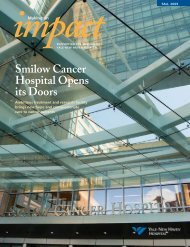


![Annual Report Donor Listings [pdf] - Yale-New Haven Hospital](https://img.yumpu.com/49673575/1/190x245/annual-report-donor-listings-pdf-yale-new-haven-hospital.jpg?quality=85)

